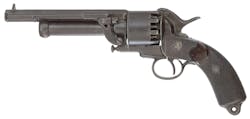Apparently many of you have quite the collection of Civil War era firearms as well as reproductions. A couple readers took umbrage to me skipping some specific handguns used during the war. So, without further ado I give you two of the more obscure pieces: the LeMat Revolver and the Lefaucheux M1858. I promise to try and cover even the most esoteric when I can and if you have a specific piece you’d like covered, email me.
The Lefaucheux M1858 was based on the designs of Casimir Lefaucheux and fired a 12mm pinfire cartridge. Casimir is often credited for designing the first self-contained cartridge system. It fired a conical bullet from a cardboard “shell” with a copper base. The M1858 round was entirely metallic. This revolver has the distinction of being the first metallic cartridge revolver adopted by a government but was never issued to the French Army. The Navy was issued the piece in limited numbers in 1858 but it wasn’t until the French deployed to Mexico in 1862 that the M1858 was put to the test.
The Lefaucheux M1858 was loaded from a hinged gate on the right side of the frame, similar to that of Colt except the gate opened upward (see detail photo). Spent cases were ejected by way of a rod running half the length of the barrel. The Federal (Union) government purchased over 12,000 M1858 revolvers in 1862 and issued them primarily to the cavalry. Union soldiers often called to these pistols the “French Trantor” in reference to the English firearms designer William Tranter. These were very popular until Colt and Remington revolvers became more commonplace.
Our second pistol this month was commonly referred to as the Grapeshot Revolver. The LeMat Revolver was designed by Dr. Jean Alexander LeMat of New Orleans and Pierre Gustave Toutant (P.G.T.) Beauregard in 1856 and deployed within the Confederate Army. LeMat and Beauregard would obtain the ranks of Colonel and General, respectively. The revolvers were originally produced by John Krider in Philadelphia, PA. Production was moved to Europe during the war resulting in some 2900 examples produced by various manufacturers.
What made this particular revolver so unique is that it was designed with a 9 shot cylinder firing through a conventional rifled barrel over a large bore single shot barrel. The second barrel was centered on the cylinder and would serve as the cylinder pin.
The initial shipments of the LeMat revolver came with .40 caliber-rifled barrel over a .60 caliber Grapeshot. Constructed of blue steel with walnut grips and totaling 13.25 inches long it was manufactured with octagonal as well as round barrels. The upper barrel was 6.75 inches long and the lower only 5. The lower rounds were loaded by way of ramrod.
Because the initial production was in .40/.60 calibers, rounds were not standard. Those who carried this pistol were forced to cast their own bullets. Later versions in .42 and .35 didn’t improve matters. Today you can purchase reproductions in .44 caliber (if you’re interested). The LeMat was eventually designed for pinfire rounds but I’ve yet to find any concrete evidence of production. In later years the pistol was produced n Belgium and chambered in 12mm Perrin or 11 Chamelot-Delvigne over a 24 gauge shotgun barrel.
Several Confederate officers including General Beauregard, Maj. Gens. Richard H. Anderson and Colonel George S. Patton were known to carry the LeMat revolver and it is said that J.E.B. Stuart was an ardent fan. While both of these pistols served to help refine firearms designs of the day neither would become commonplace following the war. They do show innovations that would later develop into manufacturing more modern pistols but the proliferation of the Colt and Remington designs would render these pistols as curios.
About The Author:
Charles Bennett was born in our Nation's Capital and grew up in the Maryland suburbs. Mr. Bennett has been working in all aspects of the publishing industry since the late 1980s primarily in the fields of commercial photography and magazine production. Moving to California in 1992 to attend college resulted in B.F.A and Masters degrees. California also supplied Mr. Bennett with his wife. The two of them are avid sports persons and participate in shooting, scuba diving, surfing, running and bicycling. As a long time hobby Mr. Bennett has studied the legends of American law enforcement which led to his writing these columns.
About the Author
Charles Bennett
Charles Bennett was born in our Nation's Capital and grew up in the Maryland suburbs. Mr. Bennett has been working in all aspects of the publishing industry since the late 1980s primarily in the fields of commercial photography and magazine production. Moving to California in 1992 to attend college resulted in B.F.A and Masters degrees. California also supplied Mr. Bennett with his wife. The two of them are avid sports persons and participate in shooting, scuba diving, surfing, running and bicycling. As a long time hobby Mr. Bennett has studied the legends of American law enforcement which led to his writing these columns.

